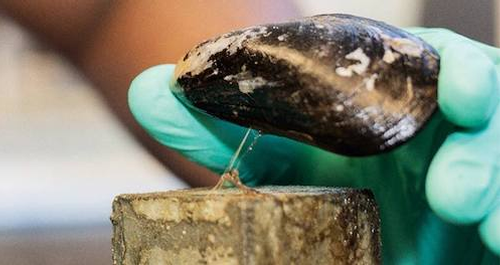Research Looks to Mussels for Concrete Adhesive
MONDAY, MARCH 15, 2021
Researchers at the University of Delaware have received an NSF Career Award to create new durable adhesive joints for concrete structures. Studies are reportedly mimicking mussel adhesion for the development and are aiming to add their work to affordable housing and next-generation infrastructure.
The university announced that Jovan Tatar, assistant professor of civil and environmental engineering and affiliated faculty in the Center for Composite Materials, received the award last week.
About the Research
Tatar notes the issues that occur when concrete adhesives are exposed to moisture and points to the special adhesives used in the automotive and aerospace fields.

 |
| University of Delaware |
|
Researchers at the University of Delaware have received an NSF Career Award to create new durable adhesive joints for concrete structures. Studies are reportedly mimicking mussel adhesion for the development and are aiming to add their work to affordable housing and next-generation infrastructure. |
“Similar benefits could be attained in the structural engineering field with adhesives that are specifically designed to withstand the environmental stressors and structural demand in concrete structures,” he said. “This need in the field has inspired me to seek nature-inspired solutions for durable adhesive bonding to concrete.”
In addition, the National Institute of Standards and Technology report recently identified externally bonded fiber-reinforced polymer composite retrofits as critical for making concrete infrastructure more resilient to natural disasters or decay.
Moreover, the NIST identified the durability of adhesive bonds to concrete in structures where moisture is a significant concern as the highest priority research area.
Enter: mussels. These organisms establish and maintain their adhesion underwater, mostly on substances that are made of minerals similar to concrete.
“By enabling durable adhesive bonding to concrete, this project will improve the durability of EBFRP retrofits, which addresses two important needs: The National Earthquake Hazards Reduction Program’s call to improving retrofit technology and the National Academy of Engineering’s Grand Challenge to restore and improve urban infrastructure,” said Tatar.
The thoughts is that a new, stronger adhesive could join forces with prefabricated structural components and 3D-printed concrete to accelerate production of affordable housing.
“I envision fundamental advances in the understanding of bio-inspired adhesion to concrete will enable the development of durable adhesive joining techniques that support innovation and increase productivity in the construction sector,” he added.
Previous Adhesive Research
In 2019, researchers at Purdue University turned their attention to tannic acid—an ingredient commonly found in medicine and beverages—to improve the strength of some adhesives.
Researchers have concluded that the acid can improve adhesives, along with coatings and manufacturing composites, and are using their discovery for epoxy-based polymers.
“There are few high-temperature hardeners that are sustainable,” said Jeffrey Youngblood, a professor of materials engineering in Purdue’s College of Engineering, who is on the research team along with John Howarter, an associate professor of engineering, and Matthew Korey, a National Science Foundation graduate research fellow.
“Our technology is designed to improve sustainability without sacrificing performance.”
Typically, a hardening agent is added to epoxy polymers to aid in stability and stiffness for high-temperature environments. Here, the tannic acid is the hardener.
“It is more sustainable than other options, has less environmental impact and is relatively inexpensive,” Youngblood said.
“My research group is heavily involved in developing sustainable materials. Sustainable materials typically have lower performance, which compromises the public perception and penetration into the market. Here, such a trade-off is not necessary.”
Tagged categories: Adhesion; Adhesive; Coating Materials; Concrete coatings and treatments; Research and development







